The Brachytherapy Market is estimated to be valued at USD 1243.4 million in 2025 and is projected to reach USD 2943.5 million by 2035, registering a compound annual growth rate (CAGR) of 9.0% over the forecast period.
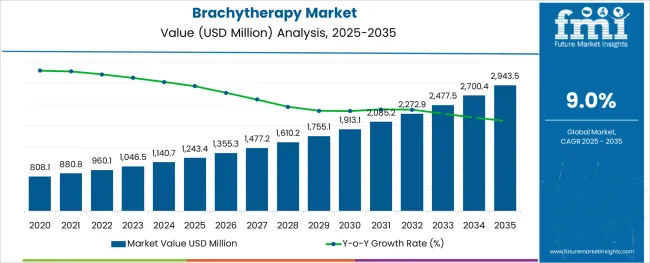
The alginic acid market is undergoing consistent growth, propelled by rising demand from food processing, pharmaceutical formulations, and cosmetic applications. A growing focus on natural and sustainable ingredients in manufacturing processes has positioned alginic acid as a preferred biopolymer across industries.
The market is further supported by its diverse functional benefits, including water retention, gelling, and stabilizing properties, which make it indispensable in high-performance formulations. Increased regulatory acceptance of alginates as safe additives and the push towards cleaner labeling in food and personal care products have reinforced their adoption.
Ongoing innovation in extraction technologies and the utilization of algae as a renewable resource are paving the way for cost-effective production and expanded applications, ensuring sustained market expansion in the coming years.
The market is segmented by Product Type, Dosage Type, and Application and region. By Product Type, the market is divided into Seeds, Applicators & Afterloaders, and Electronic Brachytherapy. In terms of Dosage Type, the market is classified into HDR Brachytherapy and LDR Brachytherapy. Based on Application, the market is segmented into Prostate Cancer, Gynecological Cancer, Breast Cancer, and Other Applications. Regionally, the market is classified into North America, Latin America, Western Europe, Eastern Europe, Balkan & Baltic Countries, Russia & Belarus, Central Asia, East Asia, South Asia & Pacific, and the Middle East & Africa.
The market is segmented by Product Type, Dosage Type, and Application and region. By Product Type, the market is divided into Seeds, Applicators & Afterloaders, and Electronic Brachytherapy. In terms of Dosage Type, the market is classified into HDR Brachytherapy and LDR Brachytherapy. Based on Application, the market is segmented into Prostate Cancer, Gynecological Cancer, Breast Cancer, and Other Applications. Regionally, the market is classified into North America, Latin America, Western Europe, Eastern Europe, Balkan & Baltic Countries, Russia & Belarus, Central Asia, East Asia, South Asia & Pacific, and the Middle East & Africa.
When segmented by salts, sodium alginate is expected to command 27.5% of the market revenue in 2025, marking it as the leading subsegment in this category. This leadership has been driven by its superior solubility, ease of incorporation into formulations, and versatility in a wide range of applications.
Its ability to form stable gels and maintain viscosity under varying conditions has made it highly sought after in both food and pharmaceutical sectors. Manufacturers have prioritized sodium alginate due to its consistent performance, cost-effectiveness, and regulatory acceptance, which have collectively strengthened its position.
The segment’s prominence has also been enhanced by its adaptability to evolving consumer preferences for plant-derived and sustainable ingredients, reinforcing its market share.
Segmented by end user industry, the food industry is projected to hold 33.0% of the market revenue in 2025, positioning it as the most prominent sector. This dominance has been shaped by the industry’s increasing reliance on alginic acid and its derivatives to deliver desirable textures, stabilize emulsions, and improve shelf life of processed foods.
As consumer demand for clean label and natural additives has intensified, the food sector has responded by integrating alginates into bakery, dairy, and confectionery products. Enhanced production efficiency and compliance with food safety standards have further encouraged widespread use.
The segment’s leadership has also been supported by product differentiation strategies where alginates contribute to premium quality and innovation, securing their role in modern food formulations.
When analyzed by functionality, thickening agents are forecast to account for 29.0% of the market revenue in 2025, establishing themselves as the dominant functional category. This preeminence has been underpinned by the growing need for consistent texture and viscosity in a wide array of end products.
Alginic acid’s natural origin and high efficiency in creating uniform, stable thickness without altering taste or color have solidified its appeal. The demand for thickeners in both edible and topical applications has expanded, with manufacturers leveraging its rheological properties to meet performance and regulatory requirements.
The functionality’s leading share has also been reinforced by the ability to deliver cost savings through lower dosages and its compatibility with other ingredients, securing its position as an indispensable component in formulation strategies.
As per the Brachytherapy Market research by Future Market Insights - a market research and competitive intelligence provider, historically, from 2020 to 2024, the market value of Brachytherapy increased at around 7.2% CAGR.
During the projected period, the market is likely to develop due to rising cancer incidences, and technical improvements in brachytherapy. The variety of imaging techniques available, many of which can be utilized in real-time, has substantially extended the brachytherapy options.
Ultrasound, Power Doppler imaging, positron emission tomography, and magnetic resonance imaging techniques are some of the techniques of brachytherapy.
As per the American Cancer Society, the number of new cancer cases globally is anticipated to reach 2943.5 million by 2035, with more than 1140.7 million cancer fatalities. According to the reports presented by WHO, cancer claimed the lives of around 10 million people in 2024.
Breast cancer is also one of the most frequent cancers, with an estimated 2.26 million new cases in 2024.
Radiation treatment can be used to treat cancer in three ways: preventive, palliative, and curative. It can also be used on its own or in combination with other therapies including surgery, immunotherapy, and chemotherapy.
Radiation's wide range of applications has raised its appeal among doctors. The most recent breakthroughs in radiation treatment enable a high dosage to be delivered to the target location while causing minimal harm to neighboring healthy tissues.
This has increased the possibility of localized tumor management and improved cure rates, leading to an increase in the demand for radiation treatment.
Advances in the healthcare IT industry, expanding healthcare infrastructure, increased public-private partnerships, investments in cancer treatment, and rising demand for advanced care solutions are driving the market expansion.
Radiation treatment is constantly changing and advancing owing to the advancement of groundbreaking technologies. People are being educated about cancer and its treatments through new initiatives and awareness activities.
For example, on 7 April 2025, also regarded as World Health Day, as per the strategy of WHO, the International Agency for cancer and research. Alongside, the Union for International Cancer Control and African Cancer Registry Network launched a publication to commemorate the occasion.
The report presents the effort dedicated to the annihilation of cervical cancer in African countries.
In 2024, North America held the largest share of the global Brachytherapy Market. It accounted for over 35% of the global revenue derived from Brachytherapy. The surge is being fuelled by rising cancer rates combined with an aging population.
Some of the key factors for regional market expansion are government support for the healthcare sector's development, a high level of cancer awareness, easy access to high-quality medical facilities, and advantageous reimbursement policies.
The growing number of cancer-care product advancements is assisting in the reduction of cancer-related mortality in North America. For example, as per the report published by the American Cancer Society, to overcome treatment resistance in cancers, researchers used a DNA origami/trojan approach.
Also, techniques like self-eradication of cancer during meiosis or electro-permeabilizing the cancer cell membrane are also developed in America.
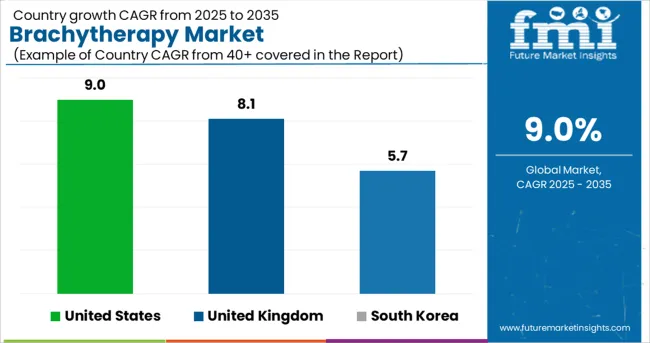
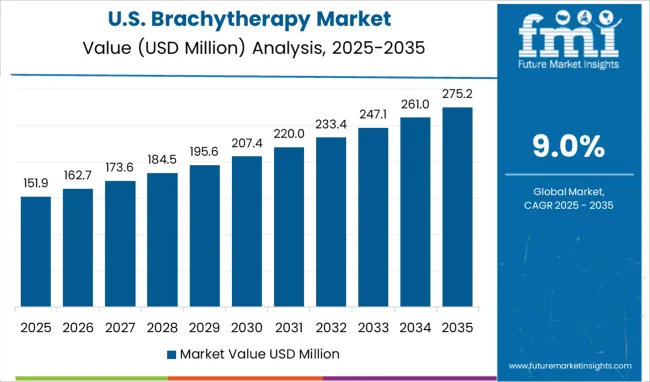
The United States is expected to account for the highest market of USD 2943.5 million by 2035. The market in the country is expected to register an absolute dollar opportunity of USD 486 million and a projected CAGR of 9%.
Due to many variables such as Research and Development (R&D) spending, high healthcare expenditures, the existence of significant companies, and the growing number of cancer patients, the United States is the largest market for brachytherapy.
AngioDynamics, Inc., Hologic, Inc., Isoray, Inc., and Sun Nuclear Corp. are among the leading companies operating in the USA brachytherapy market. To stay competitive in the market, players are using different strategies such as mergers and acquisitions, and collaborations to significantly contribute to market growth.
The brachytherapy market in the United Kingdom is projected to reach a valuation of USD 83 million by 2035. Growing at a CAGR of 8.1%, the market in the country is expected to gross an absolute dollar opportunity of around USD 1243.4 million from 2025 to 2035.
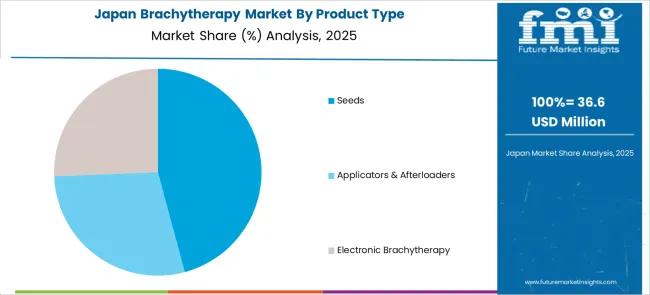
In Japan, the market for brachytherapy is projected to garner USD 71.4 million by 2035. During the forecast period, the market is expected to garner an absolute dollar opportunity of USD 37 million, registering an absolute dollar opportunity of USD 37 million.
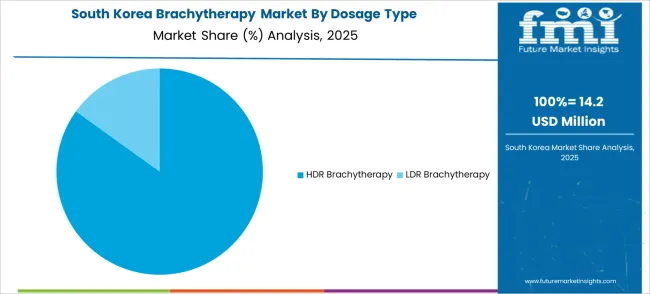
The market in South Korea is expected to reach USD 31 million by 2035 growing at a CAGR of 5.7% during the forecast period. From 2025 to 2035, the market is expected to register an absolute dollar opportunity of USD 13.3 million.
The market revenue through Applicators and Afterloaders is expected to grow at a CAGR of 1.6% during the projection period. Because they are more efficient and are utilized for patient guidance across the cancer care continuum, this therapy plays a crucial role in cancer treatment. Increased investment in cancer research and development also contributes to rising demand for the therapy.
The market revenue through the Breast Cancer application is forecasted to grow at the highest CAGR from 2025 to 2035. This is mostly due to the rising incidence of breast cancer globally. Breast cancer has affected 1140.7 million people worldwide in 2024, with 690,000 fatalities. Breast cancer has affected almost 808.1 million women during the period between 2020 to 20, making it the most common disease in the world.
The most frequent type of brachytherapy for breast cancer patients is intracavitary brachytherapy. In this method, a radioactive substance-containing device is implanted into the body and remains there until the therapy is finished.
Furthermore, increased government initiatives to raise awareness and technical breakthroughs in minimally invasive surgical treatments contribute to the market's growth.
HDR (High-Dose Rate) Brachytherapy commanded the largest revenue as well as a CAGR of nearly 1.3%, during the forecast period. The reason pertains to the advantages it provides to cancer patients.
HDR brachytherapy is a type of radiation therapy in which a large dose of radiation is delivered directly to the prostate. This implies that neighboring healthy tissue receives a low dosage of radiation and is less likely to be harmed or produce negative effects.
HDR brachytherapy can be used to treat a wide range of illnesses, including delivering accurate radiation to cancerous tumors while preventing radiation damage to surrounding tissue, instead of the five to seven weeks that regular radiation usually takes.
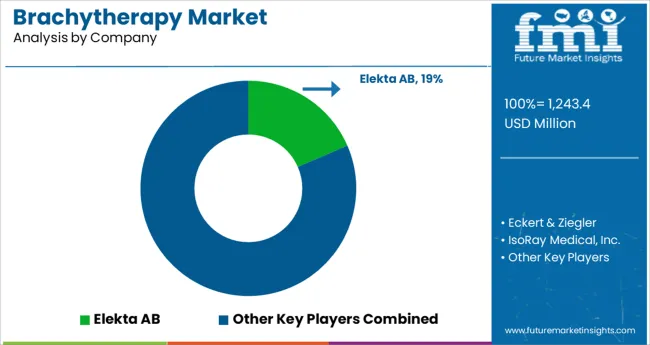
Some of the key players in the brachytherapy market include Eckert and Ziegler Group, Isoray Inc., Elekta AB, Theragenics Corp., Becton, Dickinson and Co., Varian Medical Systems Inc., iCAD Inc., CIVCO Medical Solutions, Sun Nuclear Corp., Huiheng Medical Inc., AngioDynamics Inc., and Hologic, Inc.
Some of the recent developments of key Brachytherapy providers are as follows:
Similarly, recent developments related to companies in the Brachytherapy market have been tracked by the team at Future Market Insights, which are available in the full report.
The global brachytherapy market is estimated to be valued at USD 1,243.4 million in 2025.
It is projected to reach USD 2,943.5 million by 2035.
The market is expected to grow at a 9.0% CAGR between 2025 and 2035.
The key product types are seeds, applicators & afterloaders and electronic brachytherapy.
hdr brachytherapy segment is expected to dominate with a 62.0% industry share in 2025.






Full Research Suite comprises of:
Market outlook & trends analysis
Interviews & case studies
Strategic recommendations
Vendor profiles & capabilities analysis
5-year forecasts
8 regions and 60+ country-level data splits
Market segment data splits
12 months of continuous data updates
DELIVERED AS:
PDF EXCEL ONLINE
Brachytherapy catheters Market

Thank you!
You will receive an email from our Business Development Manager. Please be sure to check your SPAM/JUNK folder too.
Chat With
MaRIA